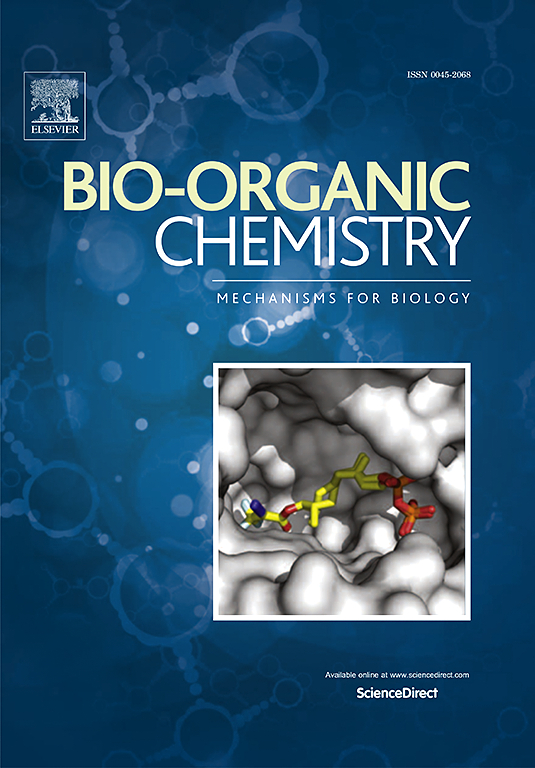Diterpenes as nitric oxide secretion inhibitors from Kaempferia koratensis rhizomes
IF 4.5
2区 医学
Q1 BIOCHEMISTRY & MOLECULAR BIOLOGY
引用次数: 0
Abstract
Kaempferia koratensis Picheans. (Zingiberaceae), known locally as “Proa Korat” or “Wan Proa Khao,” is native to northeastern Thailand where it is widely used for its aromatic properties in the local cuisine. Given its potential for expanded applications in traditional medicines, and for foods and food supplements derived from certain Kaempferia species, this study focused on the metabolites of K. koratensis rhizomes and evaluated their in vitro anti-inflammatory properties. Eight new isopimarane diterpenoids were isolated, including five koratones A–E, two koratanes C and D, and a bisditerpenoid, named as koratensin, together with six known isopimarane diterpenoids. The anti-inflammatory properties were evaluated by inhibiting nitric oxide production, with curcumin used as a positive control. The results revealed that koratone B was the most potent isolate at 25 μg/mL with 36.54 ± 0.79 % inhibition and koratane D at 50 μg/mL with 58.85 ± 4.12 % inhibition. Molecular docking of koratone B suggested the inhibitory effect was due to an affinity for hydrogen bonding at the active site of iNOS. The physicochemical and pharmacokinetic properties of koratone B were calculated. These findings indicate that selected isopimarane diterpenoids from K. koratensis, such as koratone B, merit further developmental consideration to potentiate the observed biological response.

山柰根茎中二萜类一氧化氮分泌抑制剂的研究
山柰。(姜科),在当地被称为“Proa Korat”或“Wan Proa Khao”,原产于泰国东北部,因其芳香的特性在当地烹饪中被广泛使用。鉴于其在传统药物以及某些山柰属植物衍生的食品和食品补充剂中的应用潜力,本研究重点研究了山柰根状茎的代谢物,并评估了其体外抗炎特性。共分离到8个新的异烷二萜,包括5个koratones a - e, 2个koratanes C和D, 1个命名为koratensin的双二萜,以及6个已知的异烷二萜。以姜黄素为阳性对照,通过抑制一氧化氮的产生来评价其抗炎特性。结果表明,koratone B在25 μg/mL时的抑制率为36.54±0.79%,koratane D在50 μg/mL时的抑制率为58.85±4.12%。koratone B的分子对接表明,其抑制作用是由于对iNOS活性部位的氢键具有亲和力。计算了koratone B的理化性质和药动学性质。这些发现表明,从koratensis中选择的异吡马烷二萜,如koratone B,值得进一步的发育考虑,以增强所观察到的生物学反应。
本文章由计算机程序翻译,如有差异,请以英文原文为准。
求助全文
约1分钟内获得全文
求助全文
来源期刊

Bioorganic Chemistry
生物-生化与分子生物学
CiteScore
9.70
自引率
3.90%
发文量
679
审稿时长
31 days
期刊介绍:
Bioorganic Chemistry publishes research that addresses biological questions at the molecular level, using organic chemistry and principles of physical organic chemistry. The scope of the journal covers a range of topics at the organic chemistry-biology interface, including: enzyme catalysis, biotransformation and enzyme inhibition; nucleic acids chemistry; medicinal chemistry; natural product chemistry, natural product synthesis and natural product biosynthesis; antimicrobial agents; lipid and peptide chemistry; biophysical chemistry; biological probes; bio-orthogonal chemistry and biomimetic chemistry.
For manuscripts dealing with synthetic bioactive compounds, the Journal requires that the molecular target of the compounds described must be known, and must be demonstrated experimentally in the manuscript. For studies involving natural products, if the molecular target is unknown, some data beyond simple cell-based toxicity studies to provide insight into the mechanism of action is required. Studies supported by molecular docking are welcome, but must be supported by experimental data. The Journal does not consider manuscripts that are purely theoretical or computational in nature.
The Journal publishes regular articles, short communications and reviews. Reviews are normally invited by Editors or Editorial Board members. Authors of unsolicited reviews should first contact an Editor or Editorial Board member to determine whether the proposed article is within the scope of the Journal.
 求助内容:
求助内容: 应助结果提醒方式:
应助结果提醒方式:


